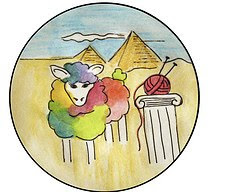Conwy.
 It helped that I used the same yarn as the pattern called for, only in a different colourway. I had tried this yarn with several other patterns in the past, with no luck.
It helped that I used the same yarn as the pattern called for, only in a different colourway. I had tried this yarn with several other patterns in the past, with no luck.Anastasia.
 This was one of those times when I saw the pattern and instantly knew which yarn I’d use. They turned out exactly as I had envisioned.
This was one of those times when I saw the pattern and instantly knew which yarn I’d use. They turned out exactly as I had envisioned.Copper Penny Socks.
 Another pattern from Knitting Socks with Handpainted Yarns (have I told you how much I love this book?). I wasn’t sure at first which pattern this yarn wanted to be but as soon as I cast on 63 stitches on a 2 mm needle I knew at the very least that I had found the right combination of needle and stitch count. When the beautiful striping continued as I began to work the lace pattern the deal was clinched.
Another pattern from Knitting Socks with Handpainted Yarns (have I told you how much I love this book?). I wasn’t sure at first which pattern this yarn wanted to be but as soon as I cast on 63 stitches on a 2 mm needle I knew at the very least that I had found the right combination of needle and stitch count. When the beautiful striping continued as I began to work the lace pattern the deal was clinched.One of the potential trouble zones of socks made from hand-dyed yarns is the heel. When you work a traditional heel flap and gusset you disrupt the flow of the yarn, first by working back and forth to create the heel flap, and then by knitting a greater number of stitches around the gusset. Sometimes pooling occurs in this area and even when you have returned to the original number of stitches after working the gusset decreases the yarn does not always behave in the same way that it did on the leg. While I did not encounter any problems when working the heel flap and gusset on Conwy, I was unhappy with the pooling and pattern disruption that did occur on the Copper Penny Socks.
I often find that substituting a short-row heel for a traditional heel flap and gusset is a satisfactory solution to these problems but even so, the colour distribution on the foot will not always match that on the leg after the heel is worked. I never thought of simply knitting the heel with yarn from the other end of the ball until I heard Gigi speak about it on the Knitmore Girls podcast. What a concept! When I reached the heel I joined in the new yarn, worked a short row heel, then carried on with the original strand for the rest of the sock, without disrupting the colour flow at all. Depending on the sock, an afterthought or a forethought heel may be more visually pleasing (ie. If you want a bull’s-eye effect) but I prefer not to deal with provisional cast-ons, grafting, or cutting my knitting if I can help it.



No comments:
Post a Comment